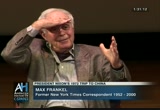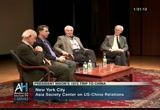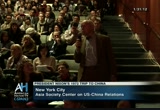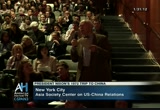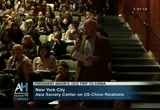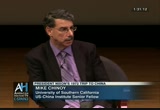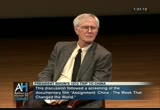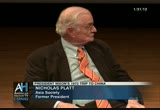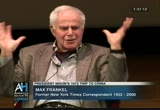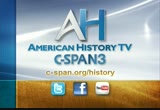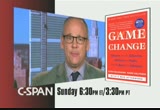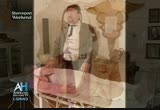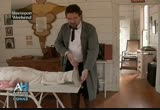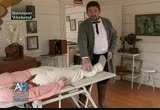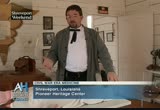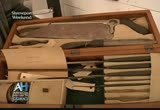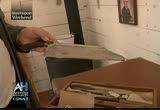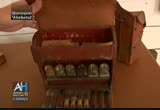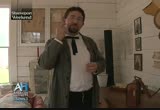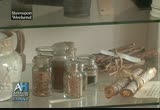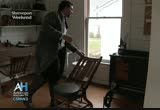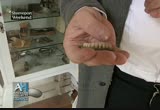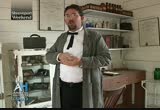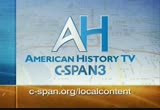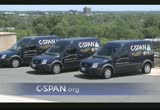tv [untitled] March 3, 2012 9:30pm-10:00pm EST
9:30 pm
department in the republicans, led, among others, by the likes of nixon. and so the best talent for analyzing china was at the cia. and it's those people that i sought out. and i was largely interested in the biographies of the people that i was likely to be covering so that i could write with some knowledge as to who these people were, who role they had played in the cultural revolution, et cetera, what the relationship might be between zhou enlai and mao and representing different factions of outlook on the world. and insofar as i could tell, they had it pretty right, yes. >> if i could add a point, the cia was quite public about briefing people on the geography and the economy and so forth. i have an atlas that was published by the cia at that
9:31 pm
time which was an unclassified document, very detailed and informative. i also know from having been an analyst for many years that 98% of the information that we got was based on basically public sources. how we got them was not necessarily unclassified. but this was pretty much public stuff, the really clandestine stuff of things was not very well developed. >> i spoke to my father on the phone and told him that i was coming here tonight and he told me to ask you that because he helped to write that atlas you referred to. he was a china analyst at that time. so -- >> who is your father? >> i'm not telling you that part. >> thank you. >> when i repeat those answers to him, he's going to be
9:32 pm
thrilled. so thank you very much. >> we have a question right here. >> this has been a wonderful film and a fascinating discussion. but i think what could be useful is to add a few more words about the context in the 1960s that led to the trip. the idea for the secret trip of henry kissinger in july '71 didn't come out of the head of ze zushgs. it began with the fullbright hearings of 1966. despite the beginning of the cultural revolution -- and this is the irony -- a growing american support for a new china policy. that's why we had the national committee on u.s./china relations formed at that time. that's why nixon just had a brief mention in his '67 foreign
9:33 pm
affairs article. in '68, our harvard m.i.t. group gave nixon and kissinger the idea for the secret trip. this was coming. the democrats were trying very hard to be the first in china. the democrats were split. the administration was saying, we're in vietnam because china is behind it. on the other hand, mcgovern said, we need a new china policy. and jim thompson and others who saw the need for this were pushing it. so you had a gradual evolution in the late '60s and henry and company were trying gingerly to take this issue away from the democrats. teddy kennedy went up to ottawa in may '71 to see the new ambassador in the hope of being the first to go to china before nixon and kissinger. but the chinese weren't having any, especially because ted kennedy refused to say that
9:34 pm
taiwan was part of china and under beijing's jurisdiction. had he been willing to give taiwan away, he might have had a chance to go. so this was all part of the democrat/republican preparation for the '72 election. and it was all part of a rising american opinion for china change. i remember arthur hummel told us in late '66, it was only the fullbright committee hearings that showed american support for a new china policy. and i said to him, you mean it's the function of the congress to lead public opinion on foreign policy and the function of the state department merely to follow it? so we had to see this in the context of democratic party people trying to take over this issue and nixon and kissinger very cleverly took it away. >> so the price of admission was to give taiwan away and nixon and kissinger were willing to do
9:35 pm
that. >> that's right. >> how ironic. >> and actually if you read the transcripts which have now basically all been released, it's amazing how blunt they are and how cavalier they are in the meetings with mao and with zhou in sort of saying, well, taiwan's not that important, we'll figure it out, we're not going to make a big fuss about it. and they were really ready to -- and then of course, kissinger -- they came back and for a period -- and both nixon and kissinger said, we're going to maintain the relationship even though privately they'd indicated to the china they were going to dispense with it. >> but in chinese terms, they were giving it away, too, as an issue. this was something that they claimed as their birthright. >> internally, yeah. >> internally. and they were really saying, we'll let this thing ride for generations. >> and they have. >> and taiwan has remained in charge of its own destiny. >> not a bad strategy.
9:36 pm
what did mao say? it doesn't matter if it takes 70 years -- >> dung said that. >> we have time for one more question. who has qu maybe right here? you pretty sure? >> one element that was mentioned in the film that i never heard a good explanation of was the very low-key reception. you mentioned it and you mentioned the cars zipping through paiking. but with nixon's desire to have more of a staged event, was that more of the chinese or what was goo low key and what did it symbolize? thank you. >> my theory is that the chinese people who were running the trip wanted to downplay this until they had found out what mao's reaction was going to be.n mao
9:37 pm
everybody relaxed. and there were a lot more people around. i remember when we were going in this motorcade, you could see that there were a lot of people down -- halfway down the various block that is we passed who were being held behind barriers and so on and so forth. but i think that there was a sense of sort of holding their breath at the outset until the actual laying on of hands by mao. >> that makes sense. >> the strangeness of this experience, on the other side, one of the most encountered wal around beijing was the number o frightened to death at the sight of me. this hairy character with a big nose, they would literally bury their faces in mamma odma'skirt
9:38 pm
crying. and as i walked along one wall oftt villages that were really surrounded by a wall with every block or so had an entrance, as wall, i could see through the opening, there was a crowd of about 50 youngsters on the other side of the wall following me along. and i could only see them every time there was an opening in the wall. we were from mars, as far as they were concerned. and so the strangeness of the experience both ways was startling, really. >> can i just add -- for those of you who can't get enough of this, it's available on the website. and there's a version with chinese subtitles with there as well. >> listen, before we sign off, i want to thank laura chang on our
9:39 pm
staff and all of our -- for helping us. and thanks to our three panelists and mike for a wonderful film. thanks for coming. [ applause ] you're watching american history tv, 48 hours of people and events that help document the american story. all weekend every weekend on c-spa c-span3. >> who all we vetted, romney, crist, pawlenty. who can we win with? >> none of them. >> obama just changed the entire
9:40 pm
dynamic. >> look inside the book that gave the inside story on what happened in the 2008 presidential campaign. >> i love those hockey differen a hockey mom and a pit bull? lipstick. >> sunday, with the co-authors. >> their expectation coming out of that speech was that she was an unalloyed asset to the campaign. for the ten or week days immediately after that, she was. and on the democratic side, there was a lot of concern as the mccain/palin ticket came out of that election. people on the democratic side were sort of freaking out. >> we'll talk about "game change" on sunday at 6:30 p.m. this weekend, american history tv is in shreveport, louisiana, expanding ourch programming on american history. shreveport is the third largest city in louisiana and is the former home of the louisiana
9:41 pm
hayride, a radio show which helped many celebrities get their start. learn more about shreveport, louisiana, all weekend long on american history tv. we're in our doctor's office here at the pioneer heritage center. modern medicine as just evolved over a short amount of time. the pioneer medicine while with whole lot of changes. it was still pretty archaic. some of the things they were still doing early on in this area, they were doing blood-letting, using leaches, doing things that modern medicine has frowned upon but we know some of circle as well. but you consider that, the things that we take for granted today when we go to the doctor, things like the instruments
9:42 pm
being as germ-free as possible or the doctor has washed his the tools are sterilized. modern painkillers, anesthetics, a lot of these things were nowhere on the radar for these doctors who were practicing. and we use the term "doctor" loosely when we're talking about early medicine. a lot of these doctors were self-taught or worked under someone else who was self-taught. they would just learn as they went. this would be the room that you would come into for possibly a tooth-pulling, if they were going to take tonsils out, if they were going to remove an appendix. if they were going to deliver a baby. if you were going to do an eye exam, you came to the one exam room that they had, warmer weather, better days, people would sit outside and wait. if it was cold and nasty, middle
9:43 pm
of winter, everybody could easily be crammed into the exam room with maybe just a sheet pulled across the patient. privacy wasn't that huge of an important thing for them to have to have when you went to the doctor. so other things that make it th during this pioneer time is if you look at our exam table we have, the exam table is -- it's all metal. this is a metal exam table wi. uld there be the clean paper like when you go to the doctor ? no. under our mannequin, there's actually a groove bent into the center tray of the exam table. and that groove runs into a pan which is basically called the blood pan and the blood groove. if the doctor was, say, removing an appendix, the blood would run around the side of the patient, into that groove and into the pan. and the smaller pan would allow
9:44 pm
the blood to drip into the larger pan on the floor. once the surgery was done, did they sterilize it? no. bucket of water and a rag. they would wash it over. that would be about as clean as they would get it. the same for their tools. a good doctor would have something similar to this, a wash basin. the soap they used was not anti-bacterial soap. it was basically homemade lye soap. they would wash up and start to do their work. but think about it. there's no x-rays. there's nothing to render you unconscious for surgery. nothing to give you for pain, what we would say were really good painkillers. you take our mannequin here and we'll say he was out breaking horses and he got thrown off a horse and he landed wrong.
9:45 pm
his foot is pointed in the wrong direction, we know it's broken because it's pointed in the wrong direction. we load him up in the wagon. they bring him into the doctor's office, five, seven miles on a bumpy road. they get him to the doctor. the doctor goes, yes, it's broken. and the doctor says, okay, the first thing we have to do is we're going to have to try to get his boots off. they would have to remove the boots. in order to do that, the first thing they would have to do is rotate the leg back into the right position. that would just entail the doctor rotating the leg back with him hollering the entire time. something else the doctors would do that they don't do today is he would ask his buddy that is brought him, i'm going to need your help. their job would be to pin him to e say i was the person who brought him in.
9:46 pm
my job would be to do this and pin him to the table while the doctor rotated that foot back up into the upright position.etrea his boot off. and he digs around in his bag. he may just pull his pocket knife out and go to cut the leather on the boot. he may moan and groan and ask the doc not to cut his boots off. why not? simple reason. it may be the only bear of shoes he had. so he would -- the doctor w mak do i cut his boot off or go by his wishes? he goes by his wishes. a doctor with a broken leg inside the boot manages to wrestle the boot loose. when he does, he hears a nice slurpy sound. he gets the boot off. there's a bulge sticking out. the bone has been exposed to the skin. so the doctor does his best -- remember, no painkillers, no
9:47 pm
x-ray. and the doctor has to try to set this bone. so the first effort is going to be, he's going to take the heel and the foot and he's going to apply pressure and pull and see if he can pull the bone back under the skin. well, that worksdon't work as w it should. so then what is he going to do? he's going to grab the ankle and take his fingers and put pressure on that broken bone and push it back through the hole that it's made through the skin and then push his finger in there so he can feel the bones and he's going to rotate the bone and foot arounnt he thinks he feels those bones come back together. and at that point, he's going to bandage it up, no plaster cast at this point.at he going to do? he's going to splint it. and splinting he would take two boards, one on each side of the leg. the wound would be bound.
9:48 pm
he would take the two boards, lay them side by side on there and then take some dressings and tightly wrap the board on and that would become the cast. they get him home, within ten days, maybe a little longer, the house starts getting this kind of foul odor to it. they notice there may be flies buzzing around the wound and infected. -- their biggest fear of course, an infection was not something you wanted to get on any major scale because with gangrene setting in, they didn't have any antibiotics to apply to it or to even give them orally to try to fight the infection. you had to hope your body was strong enough to fight it off.i cure-all for infection was an amputation. the doctor said,goin iasto happ would get infected. why did it get infected? maybe because the doctor had his fingers in the wound. but he had to do what he had to
9:49 pm
do in order to try to save the leg. now the infection's there and the doctor would have to come up above the infected area and remove the leg. and it would generally -- first amputation would be at the knee. they would come up maybe midpart of the thigh. they would use something very crude and very -- what we would say very crude. but it would be an amputation kit. the amputation kit would have everything needed to actually remove the limb. and most doctors would be pretty practiced in amputation, especially after the american civil war because they had just had hundreds of thousands of patients to work on. so amputation was the route to go. so they would take their amputation tools. and the first one that they would have to use would be the scalpel. these are not nice and delicate tools, as you can see. it's long, very narrow, got a very s the reason for the length is
9:50 pm
because this blade here would have to be pushed completely through the thigh. through the top and out the bottom. then they would take the bone saw and bone saw. and the bone saw is very small teeth on it. and it would be used to, just like it says, to saw through the bone. and it would saw the bone as close up to the top as they could. what they would do they would cut the bone higher than the flesh would be when they folded it back wou fold that flesh ba over the shortened bone and stitch that and that would make the stump. so you would think that a lot of patients would die with this type surgery. but it was a very effective surgery done properly. you know, we talk about doctor's office now because we have a doctor's office here. but a lot of times like i mentioned earlier these doctors were tenant farmers. they farmed and they did. but they were also what was called saddle bag doctors. saddle bag doctors were doctors that not only stayed homebound at their doctor's office but
9:51 pm
they would go out and roam the countryside and go to these small communities. we have a great example of what these saddle bag doctors would carry. not only would they have a saddle bag possibly with their amputation kit and surgical kits and what not. but we have a great example here of a saddle bag doctor's kit that has all the medicines he would have had and needed at the time. you see they're each individually holed, held by leather straps and what not. there's vials and bottles a the bottles lean out so the doctor can gain access to them. the top would have been areas where he would have kept spoons and maybe smaller portions of medicines and whatnot. and this would have all been closed up and carried by the doctor on horseback. and this would be his medical bag. a lot of the medicines during this time were based -- had
9:52 pm
coca-based, open opium-based. they didn't have real medical properties they just made you feel real good that they were there. for medicines they would use dandelions which was great for when you were constipated. willow bark, that's the basic ingredient for an aspirin. it was a great painkiller. one of my favorites that they use was a tree called tickle tongue. that is what they would use prior to doing any dental work you. can suck on it and it will make your mouth go numb. as good as know novocaine? no. but it was better than nothing. this was the doctor's dental office and also the pharmacy there. would be jars and vials of ground-up pouders and whatnot. he would make his own pills and his own medicines that way. and of course, like i said, they used things that grow naturally.
9:53 pm
some of them actually did have some medicinal purposes and actually worked. some of them did not. a lot of these recipes they didn't even call them prescriptions that they used for medicines calls for things that are poisonous. so there's recipes that call believe it or not that have require that you put three drops of hemlock in it. and hemlock is very poisonous. there's several that call for crushed up buckeye seeds. buckeyes are poisonous. so the rule of thumb was, a little could cure you and a lot could kill you. so the doctor would have had his pharmacy, his scales for weighing the pouders and what not and measuring out everything into the way he would have needed it. if you look here we have our dental chair and our dental
9:54 pm
drill. our dental dral is what's referred to as a treadle drill. it runs like a treadle sewing machine. it would have had belts and pullies. you would use foot power to get the belt turning. you can hear it's nice and squeaky so you can imagine that dental drill sound. and it would have that. and that would go up and then of course that would be what would cause the drill bit to turn and the dentist would use that to drill your teeth. our dental chair that you see here is a and medical chair, that would have r. g.a.ed in the circa around priorson which was south of here. and true blue the reason we know it's a true blue dentist and medical chair is number one by the design and by its so if you foot pedal here, the
9:55 pm
chair can lean back and you can get a lotof angle to the patient who's laying in a chair. but the big thing is, is the absence of any arms built from this chair. because in order for the doctor to be able to pull a tooth he had to keep you as immobile as he could. so the patient would sit in the chair back against the backup cord. the doctor himself would actually just step over the to the chair so he could work on the patient's mouth and basically keep his body fromov pulling of teeth? just kind of like today but not the novocaine or anything that they would give you. plyers were used to move an impacted tooth. ool called a tooth key. the tooth key consists of a handle, a shaft and a hook. and it's a hand hook.
9:56 pm
and we'll pretend that our tooth and you would hang that at the base of the gum right on the edge of the tooth and rotate it around. and then usingower and leverage you would rotate the george t of the gum line. washington having wooden teeth. well, they weren't always wooden. as the years would go by, eventually they would start making dentures and false teeth. and if we look we have ivory teeth that would be used or porcelain. porcelain was used a lot, too. but the unique things about these dentures are that they are toxic. because the base that they made and used they used lead to hold these teeth in place. so you pop these in your mouth and your gums are fairly absorbent and they're pulling toxins out left and right. so you wear them for a few weeks and all of a sudden you start feeling kind of sickly.
9:57 pm
doctor doesn't know about lead poisoning at the time. he tells you stay off your feet for a few days and hopefully you'll get to feeling better. so you're not going to wear your dentures while you're bed so you set them on the table. you get to feeling better, you're back on your feet. so you put your teeth back in. and then you get sick again. so you can get lead poisoning just from wearing your dentures at the time. you know, we talked about the doctors themselves. regionally when you look at this time period, the 1830s to the 1930s, we go 1849 the records show that there were only 87 doctors in the western half of louisiana. that's pretty scarce when you talk about a state, a whole state. the next time you go to your doctor be sure to hug his or her neck or shake his or her hand
9:58 pm
and tell them thank you just because of the amount of time they issued into their schooling and everything they've done to help bring up us into this modern world. all weekend american history tv is featuring shreveport, louisiana. learn more about shreveport and find out where c-span local content goals are going next online at c-span.org/local content. you're watching american history tv all weekend every weekend on c-span 3. hi there. i'm mark park you can s. i head up c-span lcd project. it stands for low content vehicle. the purpose of these vehicles is to collect programming from outside of washington, d.c. how do we do it? we staff each one of these with -- a laptop editor so they're able to roll, record,
9:59 pm
produce and edit things from the road. so that's what we're doing with the lcvs. why i want to do this is to get outside of washington, d.c. and collect programming for all of our networks. we're doing what we call lcv cities tour. we'll descend on each city with all three vehicles. one will do historic programming at historic sites. the other will do book tv programming at book stores catching up with authors. the third one does community relations events. community relations events are important to us because we work with our cable partners in each one of these cities. the last thing that's important to know is all this not only go goes on the air but gets archived on our web site, and we're doing extensive social media. you'll see us on facebook. our cable partners on facebook. you'll see four square what's really location-based and tell people where we're going. you'll see us on twitter as well. so it's a chance to get out our message not only on air but also online and through social media as well. so that'wh
104 Views
IN COLLECTIONS
CSPAN3 Television Archive
Television Archive  Television Archive News Search Service
Television Archive News Search Service 
Uploaded by TV Archive on

 Live Music Archive
Live Music Archive Librivox Free Audio
Librivox Free Audio Metropolitan Museum
Metropolitan Museum Cleveland Museum of Art
Cleveland Museum of Art Internet Arcade
Internet Arcade Console Living Room
Console Living Room Books to Borrow
Books to Borrow Open Library
Open Library TV News
TV News Understanding 9/11
Understanding 9/11